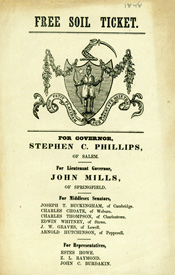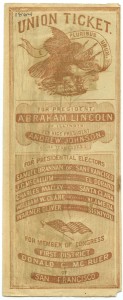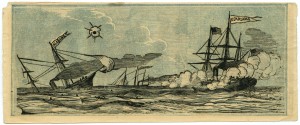With Election Day fast approaching, it seemed like a good time to have a look at the Society’s holdings of American election ballots. This is a collection of around 700 mostly New England imprints, dating from about 1815 to the 1880s. Most of the ballots are small in size and are arranged by political party, with candidates and offices listed on each sheet. Some have national or state symbols, such as eagles, seals, and flags, while others feature no-nonsense design of lists of names and offices. For a brief inventory, click here http://www.americanantiquarian.org/Inventories/electionballots.htm
 Election ballots have been used in political and other types of elections for centuries. Sometimes called a ticket, these ballots list the names of people who are hoping to be elected. In early American political elections, ballots were specific to a party, listing every person from that party who was running for office. The voter would turn in the party ballot to the voting station. By 1888, many states began instituting secret ballot voting by supplying voters with ballots that listed several parties in columns, allowing the voter to choose a particular party of individual. They could then drop the ballot in a general ballot box and keep their election choices secret.
Election ballots have been used in political and other types of elections for centuries. Sometimes called a ticket, these ballots list the names of people who are hoping to be elected. In early American political elections, ballots were specific to a party, listing every person from that party who was running for office. The voter would turn in the party ballot to the voting station. By 1888, many states began instituting secret ballot voting by supplying voters with ballots that listed several parties in columns, allowing the voter to choose a particular party of individual. They could then drop the ballot in a general ballot box and keep their election choices secret.
A recent research inquiry about a ballot for the 1864 Lincoln v. McClellan presidential campaign revealed that the Society holds a ticket for the race from San Francisco, California. The ballot is for the National Union Party, the party name under which Abraham Lincoln and Andrew Johnson ran. The Union Party was the name used by the national Republican party from 1864 to 1868 (it was not used in state races). The national re-naming was both in reaction to a split in the Republican party itself (the supporters of John C. Frémont had formed the Radical Democracy Party in May of 1864), and an attempt to attract pro-war Democrats to the Republican candidates. The Society’s ticket, from November of 1864, is designed with elaborate borders and colored inks and includes the names of the candidates for local office at the bottom. The verso of the ballot features a nautical view of the Union ship Kearsage attacking the Confederate ship Alabama, a Civil War battle which occurred in June of 1864. Perhaps the renaming of the party worked . . . Lincoln won the election with a 400,000 vote majority.
Of course, the Society’s ballot collection does not begin to cover all the election races held in the United States. For that, you should familiarize yourself with a wonderful digital resource, A New Nation Votes (http://elections.lib.tufts.edu/aas_portal/index.xq) A New Nation Votes is a searchable collection of election returns from the earliest years of American democracy, 1787-1825. The American Antiquarian Society and Tufts University Digital Collections and Archives have mounted it online with funding from the National Endowment for the Humanities. You can enter names of candidates, the state, or the name of office, and organize your results by year. A quick search on “Hewes,” for example, revealed that one of my husband’s relatives ran for the State Auditor of Pennsylvania in 1822. Alas, he did not get enough votes to win – it looks as if the seat went to the incumbent.


